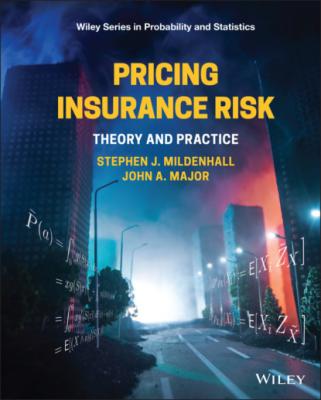Pricing Insurance Risk. Stephen J. Mildenhall
Чтение книги онлайн.
Читать онлайн книгу Pricing Insurance Risk - Stephen J. Mildenhall страница 28
 limited expected value up to a level a is the expected value with a limit a on losses. It is given by (3.7)the sum of the two shaded areas at the bottom, to the right of the curve. The integral is a Riemann-Stieltjes integral if X has a mixed distribution. Limited expected values are used to compute increased limits factors.
limited expected value up to a level a is the expected value with a limit a on losses. It is given by (3.7)the sum of the two shaded areas at the bottom, to the right of the curve. The integral is a Riemann-Stieltjes integral if X has a mixed distribution. Limited expected values are used to compute increased limits factors.
The expected loss, E[X] is the sum of the three shaded areas under the curve.
E[(a−X)+] is the insurance savings or the investor’s residual value, or, in finance, the expected value of a put option.
The diagram makes obvious a put-call parity-like relationship
The shaded area under the curve plus the put equals the strike plus the call. (Put-call parity in finance is more subtle as it relates to prices not mathematical expectations.) In insurance retrospective rating terminology Eq. 3.8 says that the expected losses plus the savings equals the attachment (entry ratio) plus the expense (Kallop 1975).
Exercise 28 Show that E[(a−X)+]=∫0aF(x)dx by computing (a−X)+=a−(X∧a) and by using integration by parts. Identify the relevant areas on the Lee diagram.
3.5.5 Algorithm to Evaluate Expected Loss for Discrete Random Variables
The algorithm in this subsection is very basic. We present it to establish an approach to working with discrete random variables that we generalize in subsequent chapters.
We present an algorithm to compute E[X] in two ways, based on Eq. 3.1,
The two integrals correspond to the areas shown in Figure 3.11, panels (a) and (b), respectively. In (a), dF equals minus the backward difference of S, and in (b) dx equals the forward difference of x.
Figure 3.11 Two ways of computing expected loss from a discrete sample.
Follow these steps to evaluate Eq. 3.9.
Algorithm.
Algorithm Input: X is a discrete random variable, taking finitely many values Xj≥0, and pj=P(X=xj).
Algorithm Steps
1 Pad the input by adding a zero outcome X = 0 with probability 0.
2 Group by Xj and sum the corresponding pj.
3 Sort events by outcome Xj into ascending order. Relabel events X0<X1<⋯<Xm and probabilities p0,…,pm.
4 Decumulate probabilities to compute the survival function Sj:=S(Xj) using S0=1−p0 and Sj=Sj−1−pj, j > 0.
5 Difference the outcomes to compute ΔXj=Xj+1−Xj, j=0,…,m−1.
6 Outcome-probability sum-product: (3.10)
7 Survival function sum-product: (3.11)
Comments.
1 Step (1) treats 0 as special because the second integral in Eq. 3.9 starts at X = 0. The case where the smallest outcome is > 0 is illustrated in Figure 3.12. Now S(x)=1 for 0≤x<X1 and ∫0∞S(x)dx includes the shaded dashed rectangle of area X1. Step (1) allows us to systematically deal with any discrete data. It adds a new outcome row only when the smallest observation is > 0.Figure 3.12 Accounting for the effect of adding 1 to each outcome.
2 After Step (3), the Xj are distinct, they are in ascending order, X0=0, and pj=P(X=Xj).
3 In Step (4), Sm=P(X>Xm)=0 since Xm is the maximum value of X.
4 The forward difference ΔX computed in Step (5) replaces dx in various formulas. Since it is a forward difference ΔXm is undefined. It is also unneeded.
5 Step (6) computes the first integral in Eq. 3.9. It is a sum because X is discrete and has a probability mass function, like a Poisson, rather than a density, like a normal—explaining why we use the notation dF(x), not f(x)dx. The sum starts at i = 1 because X0=0. Notice that P(X=Xj)=Sj−1−Sj is the negative backward difference of S.
6 Step (7) computes the second integral in Eq. 3.9. The sum starts at i = 1, corresponding to the first vertical bar in Panel (b) that extends from X0=0 to X1 and has height S(X0).
7 Note the index shift between Eq. 3.10, 3.11.
8 Both Eqs. 3.10 and 3.11 are exact evaluations. The approximation occurs when the underlying distribution being modeled is replaced with the discrete sample given by X.
Exercise 29 Apply the Algorithm to X defined by the Simple Discrete Example, Section 2.4.1.
Solution. The sorted data, starting with X0=0, is shown in Table 3.2. From now on we label the outcomes Xj as shown there.
Table 3.2 shows event rank j=0,…,m=8, and the columns S and ΔX from Steps (4) and (5). For future applications, it is important we can recover P(X=Xj) as a difference of Sj. This is easy: P(X=Xj)=ΔSj:=S(Xj−1)−S(Xj) is the jump at Xj and ΔS0 is the jump at X0=0, i.e, 1−P(X>0). It is the negative backward difference because S is the survival function. Finally, the table shows two computed columns: XΔS and SΔX. The totals show that Steps (6) and (7) give the same result for E[X], 27.25.
Table 3.2 Simple Discrete Example with nine possible outcomes, ordered by portfolio loss X, with layer width ΔX and exceedance probability S
| j | X | ΔX |
PX=ΔS
|
|---|